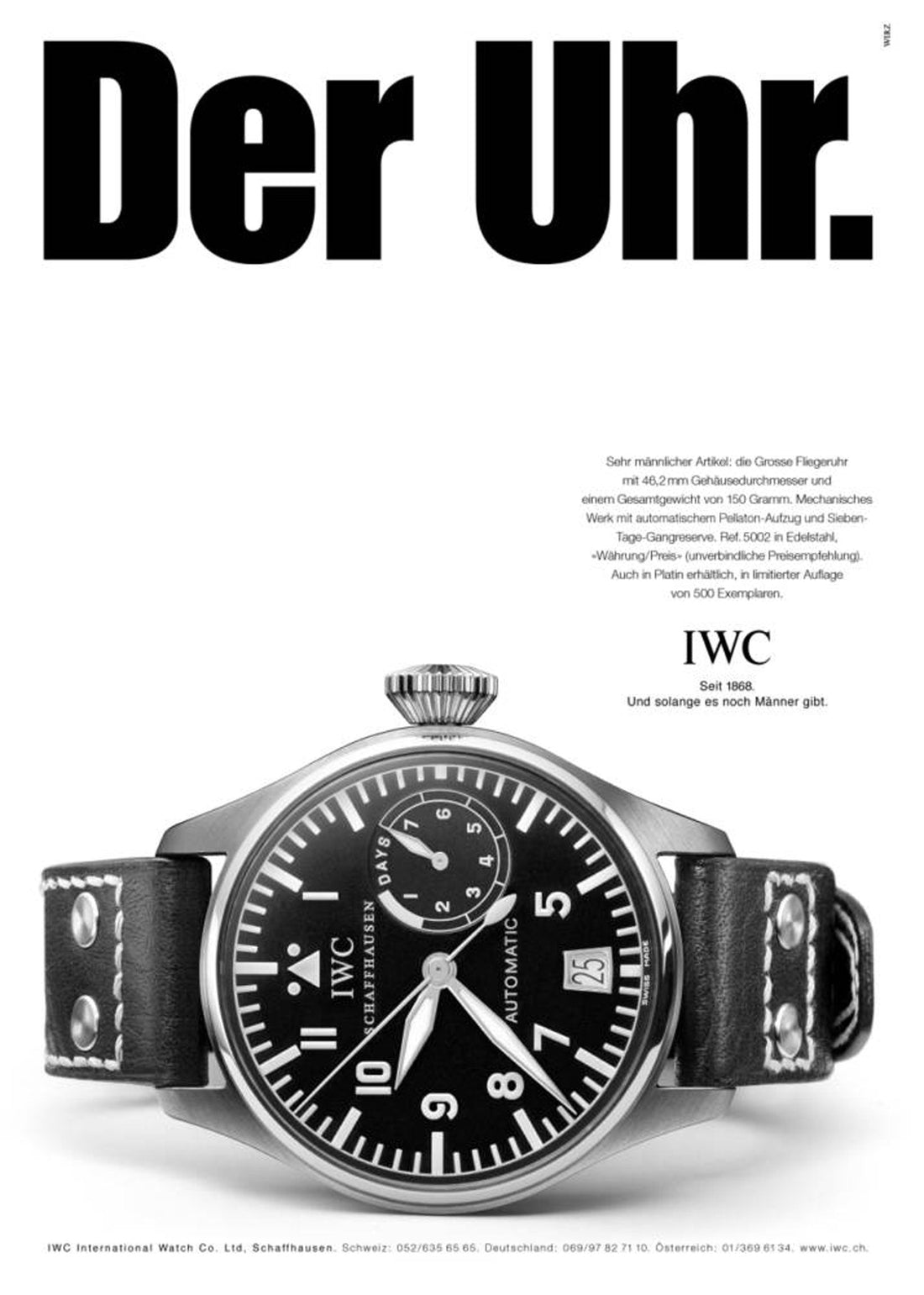
History of IWC Watches and Aviation
Florentine Ariosto Jones: From Boston to the Rhine
In 1868 a 27-year-old Boston engineer, Florentine Ariosto Jones, set out to merge American industrial production with Swiss craftsmanship. Backed by investors, he built a hydro-powered factory beside the Rhine in Schaffhausen, establishing the International Watch Company and introducing interchangeable-part calibres that would later prove ideal for cockpit instruments.
First Flight-Ready Wristwear: Spezialuhr für Flieger 1936
As open-cockpit aircraft became faster and climbed higher, pilots needed wristwatches that could withstand vibration, cold and magnetism. IWC’s answer was Reference 436—the 36 mm “Spezialuhr für Flieger”. Shatter-proof glass, an antimagnetic escapement, a rotating bezel for elapsed time and large radium-painted numerals made it a true flight tool long before radio beacons were commonplace.
Wartime Observation and the 55 mm Big Pilot 52 T.S.C.
In 1940 Germany’s air-navigation corps specified a watch readable at arm’s length, operable with gloves and accurate to the second for dead-reckoning fixes. IWC built the Big Pilot 52 T.S.C., Ref 431: a 55 mm steel giant weighing 183 g with a pocket-watch calibre 52T-SC, central hacking seconds and an oversized onion crown. Its stark dial echoed aircraft gauges, allowing bomber navigators to synchronise to the onboard chronometer before every run; many were strapped over flight jackets, explaining the extreme diameter.
Allied Navigation: Mark XI and the Jet Age
Victory did not end military demand. The British Ministry of Defence ordered a wrist chronometer for the RAF and Commonwealth air arms. IWC responded in 1948 with the 36 mm Mark XI, powered by calibre 89, shielded by a soft-iron cage and engraved “6B/346” for issue stock. Deployed in Lancasters, Hawker Hunters and later Neptune patrol aircraft, the Mark XI held its ±4 seconds-per-day spec for decades and remained in RAAF service until the early 1980s, proving indispensable for astro-nav and radio-fix calculations in the pre-GPS era.
Cold-War Cockpits and the Evolving Mark Series
The jet era brought higher G-loads and pressurised cabins, yet the visual language set in 1936 endured. Automatic winding arrived with the Mark XII in 1993, sapphire crystals with the Mark XV in 1999, and a five-day in-house calibre with the 2023 Mark XX. Though materials improved, the triangle at 12 o’clock, bold Arabic numerals and glove-friendly crown still trace unbroken lineage to the first “Spezialuhr”.
Military Partnerships Beyond the 20th Century
IWC’s ties to active squadrons continued after the Cold War. Limited editions for US Navy Strike Fighter Squadron (VFA)-102 “Diamondbacks”, VFA-211 “Fighting Checkmates” and others display squadron crests on the dial and engrave call-signs on the case-back, reinforcing the watches’ status as issued kit rather than mere commemoratives.
Materials Science: Steel, Ceramic, Titanium and Ceratanium
Operational feedback led IWC to pioneer black zirconium-oxide ceramic chronographs in 1994—lighter than steel and virtually scratch-proof—followed by full titanium cases that eased wrist fatigue for fast-jet crews. Today proprietary Ceratanium fuses titanium’s mass with ceramic hardness; experimental Big Pilot XPL cases in this alloy survive 30,000 g shock tests, exceeding ejection-seat loads.
Modern Pilot Chronographs in Service and on Screen
The current Pilot’s Watch Chronograph family distils 90 years of cockpit know-how. The 43 mm reference IW378001 pairs a 100 m-rated steel case with IWC’s column-wheel calibre 69385, a day-date display and a quick-release strap system—details that make pre-flight strap swaps and post-flight cleaning straightforward for squadron ground crews while keeping thickness to a wearable 14.8 mm. A related Performance Chronograph range supplied 120 pieces for Apple’s forthcoming motorsport film “F1”, highlighting how IWC pilot DNA now spans from jet fighters to Formula 1 pit walls.

Final Thoughts
From Florentine Ariosto Jones’s Rhine-powered factory to modern squadrons and cinema sets, IWC has advanced in lock-step with military aviation. The Spezialuhr für Flieger proved that legibility and robustness could save lives in the sky; the 55 mm Big Pilot synchronised World War II bombing crews; the Mark XI guided jet navigators across oceans; and today’s IW378001 carries that lineage forward with contemporary engineering. Across eight decades the brief has remained constant: build a wrist instrument pilots can trust when every second aloft counts.
